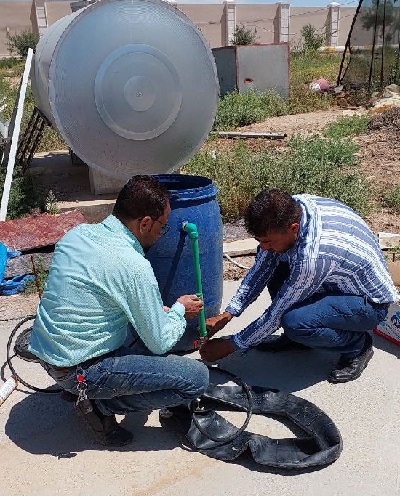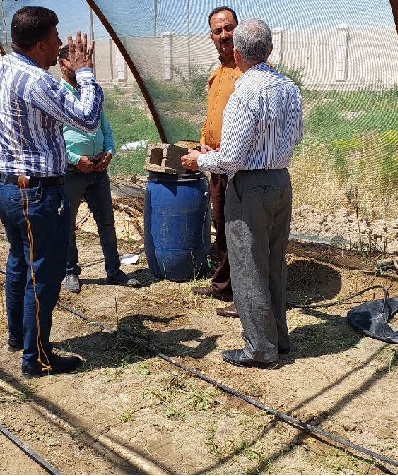The Biogas Digester_ A Sustainable Energy Production Technology for Rural Development of Iraq

Prof. Dr. Saifuldeen A. Salim , Prof .Dr. Nihad M. Abood. Dr. Harith Saddah
Center of Desert Studies
Key Word: Biogas, Energy, Rural Community, Climate Change
Biogas plants provide multiple benefits at household, local, national and global levels. The major impacts can be seen on gender, poverty, health, employment and environment of the community. Community people have become fully aware of socioeconomic development and environment protection of village. The slurry derived from the production of biogas is used as organic fertilizer for production vegetables. The vegetables thus produced have improved nutrition and have been a source of additional cooking. Most of the rural household, though they engage in agriculture also practice animal husbandry. An ordinary rural family besides owing some land for cereal production also rear cattle such as cow and buffaloes and small animal like goats and sheep. The cattle dung from these animals can be utilized for biogas production and to mitigate negative environmental impacts such climate change and soil deterioration and combat desertification throughout bulding Oasis and desert cities , while providing a source of renewable energy and promoting sustainable economic development. The output of the project is to implement biogas technology in rural areas of Iraq mainly in desert region, for rural house hold application for production of house hold energy, treatment of human animal and wastes, and production of organic fertilizer.
Development is to be directed towards, design, construction, testing and operation of different prototype digesters, as well as development of local appropriate digester designs. Performance characteristics of these digesters were determined. The Egyptian Chinese digester was selected for wider application in Egypt. The digester design was also applied successfully in some Arabic countries as Yemen, and Syria. Anaerobic digesters work on the principle that in the absence of oxygen (anaerobic means “without oxygen), naturally occurring bacteria will break down the manure. The digestion of the manure occurs in four basic stages (hydrolysis, acidogenesis, acetogenesis, and methanogenesis). It is the final stage, methanogenesis that break down the intermediate compounds to produce methane.Anaerobic digesters capture the gas released in the digestion process. This biogas is composed of about 55 to 70 percent methane. Most of the rest of the biogas is carbon dioxide, with a small amount of hydrogen sulfide and other trace gases. The digested manure needs to be stored until land applied. This physical structure invented in 1930s and developed in 1950s and 1980s, is essentially an underground and airtight pit that can receive animal manure, human faeces, and water to produce biogas and potent fertilizers. Once suitable bacteria must develop in side the biogas digester, biological waste is mixed with water in a 2:3 ratio and held at an optimal temperature of 30-40 c for approximately 50-60 days (FAO,1997). The recommended daily waste loading rate, for a conventional Biogas Digester, should be approximately 6 kg of manure per cable meter of biogas desired (FAO, 1997). It should be noted however, that given the long retention time of the manure (50-60 days), the underground chamber of the digester should have a total volume 50-60 times greater than the daily volume of manure added. In order to maximize the production of the biogas, the in put biological waste should have Carbon- Nitrogen (C/ N) content ratios of 20-30 (FAO, 1997).Such C/ N ratio can be obtained from cattle manure and other biological wastes.
.jpg)


References:
1. Erwin Koeberle. 2002. "Animal Manure Digestion System in Central Europ,"Second Biomass conference of the American August 21-24,1995Portland OR reports at east 450 digesters, more recent information suggests about 90 in Austria, 54 in Denmark, 70 in Switzerland and 1,650 in Germany ( personal communication, Joe, Resource Strategies.
2. FAO( Food and Agriculture Organization of the United Nations).1997. A System Approach to Biogas Technology. Kathmandu, Food and Agriculture Organization/Consolidated Management Services.
3. ITDG (Intermediate Technology Development Group).2004[1] Biogas and liquid Biofuels. Rugby, Intermediate Technology Development Group.
4. Gunnerson C. G. and Stuckey D. C. 1986. Anaerobic Digestion - Principles and Practices for Biogas Systems. World Bank Technical Paper No 49, The World Bank.
5. Munoz, F., Lopez,R.2004. Anaerobic Digestion System Installation of Cattle Manure in Two Farms in Puebla, Mexico” Coyoacanra, UNAM Ciudad University.
6. Rvindranath, N.H. and Hall, D. O., .1995. Biomass, Energy and the Environment: A Developing Country Perspective from India. Oxford University Press.
7. Stassen, H.E. 1995. Small-scale biomass gasifiers for heat and power: a global review. World Bank technical paper no. 296, Energy Series.
Topics may interest
Prospects of Using Bentonite in Reclaiming Desert SoilsPlant Tissue Culture for Studying the Environmental Cues
The process of hybridization in plants and methods of its development
Plant Wealth of Iraq, The History of Its Exploration and Features of Desert Region
Soil Organic Carbon Indicator
Possibility of growing nuts in the soil of Western Desert of Anbar Governorate